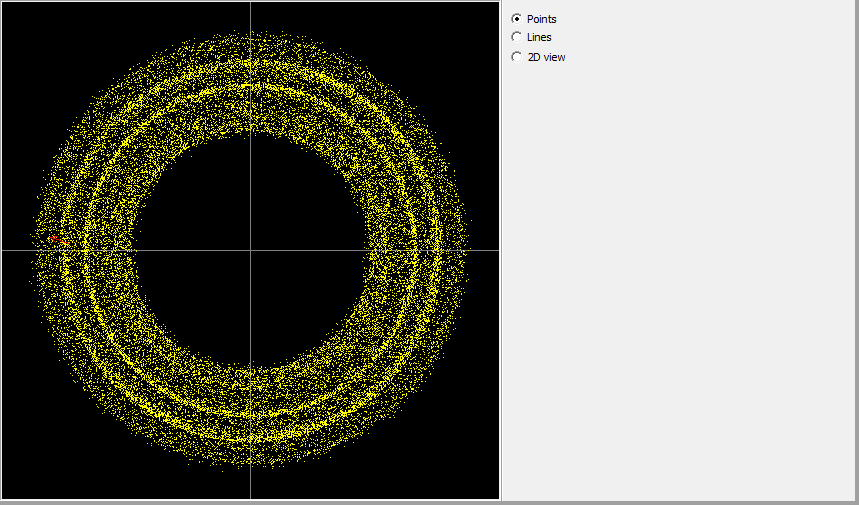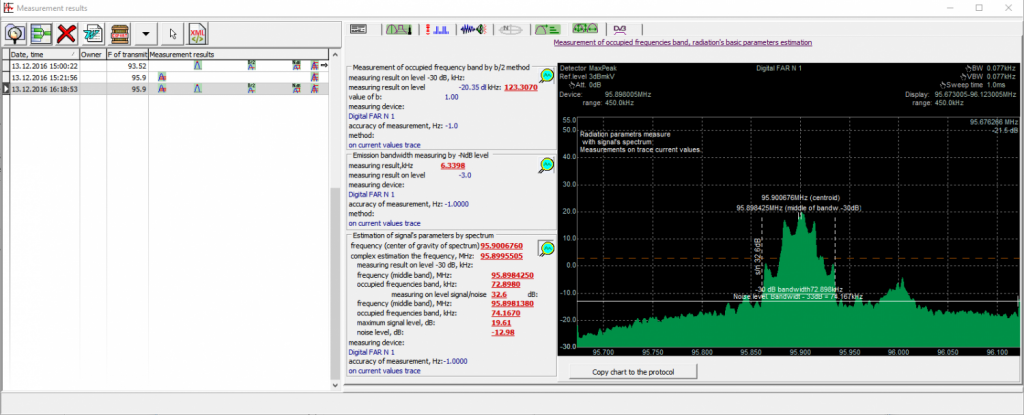RF Signal Analysis and Performance Measurement Subsystem
RF spectrum analysis requirements are determined by many factors including complex operational environments and unique mission specific objectives. To meet the wide variety of increasingly demanding requirements, RadioInspector provides operators with an advanced RF signal analysis and performance measurement subsystem that includes a comprehensive suite of industry standard tools based upon an engineering and scientific approach. This advanced subsystem offers a higher level of analysis capability to perform precise and accurate technical signal parameter measurements required for professional SIGINT, COMINT, Spectrum Management, Telecom and TSCM applications as well as for wireless and cyber threat investigation and intelligence services. While results of primary spectrum measurements have accuracy which depends on the type of instrument used for collection, RadioInspector automatically calculates accuracy at each frequency measurement point ensuring validity of individual signal measurements. Results can be saved to the integrated database and subsequently used for post event analysis.
Digital Signal Processing / IQ Data Analysis
With the advanced RF signal analysis and performance measurement capability, operators can perform RadioInspector’s digital signal processing with live IQ data analysis including phase and amplitude information, filtering, decimation, constellation diagram displayed as points, lines or 2Dview (with arrows markers indicating the phase position and the direction of movement) and Signal Classification Analysis and Recognition. The GUI also provides operators with the latest raw IQ data recording capability with sophisticated post processing and analysis.





RadioInspector’s ‘Advanced Performance Measurement’ program tool bar provides a suite of applications enabling the measurement of multiple signal technical parameter characteristics. Operators can choose measurements in dBmKV(/m), dBm(/m), dBmV(/m), dBWt(/m), dBmKWt/cm2, dBWt/m2 and measurements can be performed on current trace values, maximum trace values and average trace values. RadioInspector’s measurement calculator is also available at any time to perform instant measuring value conversions if required by the operator.
![]()
One of the most common signal technical parameter measurements is the carrier frequency of a received signal. Frequency technical parameter analysis provides the precise signal frequency the receiver is tuned to and is the first step towards determining the nature of the signal, when the connected measuring instrument has a built in capacity to precisely measure frequency.

Field Strength
Field Strength analysis includes the precise signal strength relative to background noise and the RF field strength parameters in relation to frequency, bandwidth and time. RF field strength measurements take many forms, depending on the signal being detected. The signal may be a simple continuous wave (CW) signal, a pulse or analog modulated signal, or a complex digitally modulated transmission such as an orthogonal frequency division multiplexing (OFDM) waveform.
More complex RF field strength measurements include peak power, such as found in an RF pulse, and is expressed as the maximum value of field strength over a period of time. The measurement can be averaged across a time period, such as across a series of RF pulses. It can also be integrated over a frequency band, providing useful results for mobile communications. Digitally modulated signals tend to be noise-like in nature and it is often important to have the ability to measure average and peak field strength values.
RadioInspector contains an accurate and effective application for calculating RF field strength power by using variable methods of statistical data processing for single or multiple data collection points. This also includes the capability to account for impedance and gain in the antenna system. RadioInspector’s RF field strength measurements are frequency and bandwidth selective, so unwanted signals are excluded from the desired measurement.
Other components of RadioInspector’s software can measure RF signal magnitude and phase, offering the potential for greater measurement accuracy. RadioInspector also offers fast measurement times ensuring that the operator does not need to trade-off accuracy and speed for a compromise solution. Understanding the type of RF field strength measurement, the accuracy required, and the capabilities of RadioInspector software and the associated instrument will greatly support the understanding of the operational environment.


Field Strength Measurements – Receiver Mode

Licensed commercial communications signals are allocated a specific amount of frequency spectrum, often referred to as a “channel.” The channel is defined by a regulating body, such as the ITU. Spectrum enforcement and management, Cyber and TSCM operators are often concerned with two measurements with regard to determining if a valid signal is present within a licensed spectrum. One measurement is the integrated power across the assigned channel, often called the occupied bandwidth (OBW), power-in-band, or channel power. Here the power is integrated across the channel from the assigned start to the assigned stop frequency. In RadioInspector, OBW can be calculated for the bandwidth containing from .01 to 99% of the total integrated power of the transmitted spectrum, centered on the assigned channel frequency. In addition to measuring the power in the channel, there is also a need to ensure that transmissions are not ‘spilling’ into channels assigned to other users. It may also be indicative of an illegal emitter such as a ‘rogue’ cellular base station. This test goes by many names, but it’s generically referred to as the adjacent channel power (ACP) measurement. The exact frequencies, integrated power specifications, and test methods are specified by the standards governing the transmission.
* Measuring of bandwidth and out-of-band radiators
Provides multiple bandwidth measurement results based on a variety of parameter settings and measurements to analyze interference issues, signals hiding within or close to other signals and issues impacting licensed spectrum allocation.


Signal Parameter Estimation
Signal Parameter Estimation measures additional technical signal parameters of known or unknown signals or detected anomalies in relation to other signals in a band, the noise floor or other associated parameters. Central frequency estimation for complex signals is performed by analytical methods based on spectral density. Using different measurements techniques, signal detector selection, measurement time and averaging allows high quality measurements of complex signals to be performed and correctly estimates parameters of transmitters operating in various modes. Estimation is important when faced with analysis of unknown or unregistered signals. The precise repeatable technical measurement capability of RadioInspector is an invaluable spectrum intelligence and analysis feature.


Supporting Measurements
Supporting measurements include two important aspects that are fundamental to SIGINT, COMINT, and Spectrum Management. These are: location and height of the measuring antenna and the direction finding results (angular bearing) from the measuring antenna to the signal being measured (with the proper associated hardware). RadioInspector fulfills these measurement tasks critical to professional measuring systems and requirements.

RadioInspector’s post processing program “RP”, contains the performance measurement sub-system and enables signal parameter estimation, occupied frequency bandwidth, field strength and additional frequency occupancy measurements during post analysis of saved sweep/scan files.
All results and data from the performance measurement subsystem, along with all geographic support system mapping data, can be instantly saved into the measurement results section of RadioInspector’s advanced intelligence database and can be recalled at any time for further analysis.
* RadioInspector RP Performance Measurement Post Processing

* Measurement Results Database

The signal analysis and performance measurement sub-system is well suited for building an accurate, detailed catalogue or database of signals or known transmitters with in-depth sophisticated digital processing and precise advanced technical parameter measurements.
